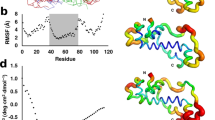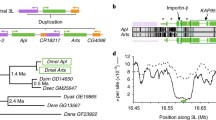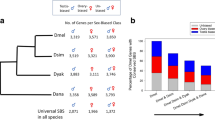Abstract
Purifying selection often results in conservation of gene sequence and function. The most functionally conserved genes are also thought to be among the most biologically essential. These observations have led to the use of sequence conservation as a proxy for functional conservation. Here we describe two genes that are exceptions to this pattern. We show that lack of sequence conservation among orthologs of CG15460 and CG15323—herein named jean-baptiste (jb) and karr, respectively—does not necessarily predict lack of functional conservation. These two Drosophila melanogaster genes are among the most rapidly evolving protein-coding genes in this species, being nearly as diverged from their D. yakuba orthologs as random sequences are. jb and karr are both expressed at an elevated level in larval males and adult testes, but they are not accessory gland proteins and their loss does not affect male fertility. Instead, knockdown of these genes in D. melanogaster via RNA interference caused male-biased viability defects. These viability effects occur prior to the third instar for jb and during late pupation for karr. We show that putative orthologs to jb and karr are also expressed strongly in the testes of other Drosophila species and have similar gene structure across species despite low levels of sequence conservation. While standard molecular evolution tests could not reject neutrality, other data hint at a role for natural selection. Together these data provide a clear case where a lack of sequence conservation does not imply a lack of conservation of expression or function.







Similar content being viewed by others
References
Adams EM, Wolfner MF (2007) Seminal proteins but not sperm induce morphological changes in the Drosophila melanogaster female reproductive tract during sperm storage. J Insect Physiol 53(4):319–331. doi:10.1016/j.jinsphys.2006.12.003
Aguadé M (1998) Different forces drive the evolution of the Acp26Aa and Acp26Ab accessory gland genes in the Drosophila melanogaster species complex. Genetics 150(3):1079–1089
Ahituv N, Zhu Y, Visel A, Holt A, Afzal V, Pennacchio LA, Rubin EM (2007) Deletion of ultraconserved elements yields viable mice. PLoS Biol 5(9):e234. doi:10.1371/journal.pbio.0050234
Assis R, Zhou Q, Bachtrog D (2012) Sex-biased transcriptome evolution in Drosophila. Genome Biol Evol 4(11):1189–1200. doi:10.1093/gbe/evs093
Avila FW, Wolfner MF (2009) Acp36DE is required for uterine conformational changes in mated Drosophila females. Proc Natl Acad Sci USA 106(37):15796–15800. doi:10.1073/pnas.0904029106
Blair SS (2000) Imaginal discs. In: Sullivan W, Ashburner M, Scott Hawley R (eds) Drosophila protocols. Cold Spring Harbor Laboratory Press, Cold Spring Harbor, pp 159–173
Begun DJ, Lindfors HA (2005) Rapid evolution of genomic ACP complement in the melanogaster subgroup of Drosophila. Mol Biol Evol 22(10):2010–2021
Bejerano G, Pheasant M, Makunin I, Stephen S, Kent WJ, Mattick JS, Haussler D (2004) Ultraconserved elements in the human genome. Science 304(5675):1321–1325. doi:10.1126/science.1098119
Cai JR, Jiang ZH, Wang W (2008) De novo origination of a new protein-coding gene in Saccharomyces cerevisiae. Genetics 179(1):487–496
Carvunis A-R, Rolland T, Wapinski I, Calderwood MA, Yildirim MA et al (2012) Proto-genes and de novo gene birth. Nature 487:370–374. doi:10.1038/nature11184
Chapman T, Herndon LA, Heifetz Y, Partridge L, Wolfner MF (2001) The Acp26Aa seminal fluid protein is a modulator of early egg hatchability in Drosophila melanogaster. Proc Biol Sci 268(1477):1647–1654. doi:10.1098/rspb.2001.1684
Chapman T, Bangham J, Vinti G, Seifried B, Lung O, Wolfner MF, Smith HK, Partridge L (2003) The sex peptide of Drosophila melanogaster: female post-mating responses analyzed by using RNA interference. Proc Natl Acad Sci USA 100(17):9923–9928. doi:10.1073/pnas.1631635100
Chen S, Zhang YE, Long M (2010) New genes in Drosophila quickly become essential. Science 330(6011):1682–1685
Chen X, Yong E, Zhang J-YC, Liu C-J, Zhou W-Z, Li Y, Zhang M, Zhang R, Wei L (2012) Hominoid-specific de novo protein-coding genes originating from long non-coding RNAs. PLoS Genet 8:e1002942. doi:10.1371/journal.pgen.1002942
Chiaromonte F, Yap VB, Miller W (2002) Scoring pairwise genomic sequence alignments. Pac Symp Biocomput 115–126
Chintapalli VR, Wang J, Dow JA (2007) Using FlyAtlas to identify better Drosophila melanogaster models of human disease. Nat Genet 39(6):715–720. doi:10.1038/ng2049
Clark AG, Eisen MB, Smith DR, Bergman CM, Oliver B, Markow TA, Kaufman TC et al (2007) Evolution of genes and genomes on the Drosophila phylogeny. Nature 450(7167):203–218. doi:10.1038/nature06341
Daines B, Wang H, Wang L, Li Y, Han Y, Emmert D, Gelbart W et al (2011) The Drosophila melanogaster transcriptome by paired-end RNA sequencing. Genome Res 21(2):315–324. doi:10.1101/gr.107854.110
Darling AC, Mau B, Blattner FR, Perna NT (2004) Mauve: multiple alignment of conserved genomic sequence with rearrangements. Genome Res 14(7):1394–1403
Darling AC, Mau B, Perna NT (2010) progressiveMauve: multiple genome alignment with gene gain, loss and rearrangement (edited by Stajich JE). PLoS one 5 (6): e11147. doi:10.1371/journal.pone.0011147
Demir E, Dickson BJ (2005) fruitless splicing specifies male courtship behavior in Drosophila. Cell 151(5):785–794. doi:10.1016/j.cell.2005.04.027
Dietzl G, Chen D, Schnorrer F, Su K-C, Barinova Y, Fellner M, Gasser B et al (2007) A genome-wide transgenic RNAi library for conditional gene inactivation in Drosophila. Nature 448(7150):151–156. doi:10.1038/nature05954
Ding Y, Zhao L, Yang S, Jiang Y, Zhao R, Zhang Y et al (2010) A young Drosophila duplicate gene plays essential roles in spermatogenesis by regulating several Y-linked male fertility genes. PLoS Genet 6(12):e1001255. doi:10.1371/journal.pgen.1001255
Feng D-F, Doolittle RF (1987) Progressive sequence alignment as a prerequisite to correct phylogenetic trees. J Mol Evol 25:351–360
Friedman EJ, Temple BR, Hicks SN, Sondek J, Jones CD, Jones AM (2009) Prediction of protein–protein interfaces on G-protein beta subunits reveals a novel phospholipase C Beta2 binding domain. J Mol Biol 392(4):1044–1054. doi:10.1016/j.jmb.2009.07.076
Fu YX, Li WH (1993) Statistical tests of neutrality of mutations. Genetics 133(3):693–709
Graveley BR, Brooks AN, Carlson JW, Duff MO, Landolin JM, Yang L, Artieri CG et al (2010) The developmental transcriptome of Drosophila melanogaster. Nature 471(7339):473–479. doi:10.1038/nature09715
Haerty W, Jagadeeshan S, Kulathinal RJ, Wong A, Ravi Ram K, Sirot LK, Levesque L et al (2007) Evolution in the fast lane: rapidly evolving sex-related genes in Drosophila. Genetics 177(3):1321–1335. doi:10.1534/genetics.107.078865
Heinen TJ, Staubach F, Häming D, Tautz D (2009) Emergence of a new gene from an intergenic region. Curr Biol 19:1527–1531
Jiang J, Benson E, Bausek N, Doggett K, White-Cooper H (2007) Tombola, a tesmin/TSO1-family protein, regulates transcriptional activation in the Drosophila male germline and physically interacts with always early. Development 134(8):1549–1559
Kaessmann H (2010) Origins, evolution, and phenotypic impact of new genes. Genome Res 20(10):1313–1326
Katzman S, Kern AD, Bejerano G, Fewell G, Fulton L, Wilson RK, Salama SR, Haussler D (2007) Human genome ultraconserved elements are ultraselected. Science 317(5840):915. doi:10.1126/science.1142430
Kleene K (2001) A possible meiotic function of the peculiar patterns of gene expression in mammalian spermatogenic cells. Mech Dev 106(1–2):3–23
Kleene K (2005) Sexual selection, genetic conflict, selfish genes, and the atypical patterns of gene expression in spermatogenic cells. Dev Biol 277(1):16–26. doi:10.1016/j.ydbio.2004.09.031
Knowles DG, McLysaght A (2009) Recent de novo origin of human protein-coding genes. Genome Res 109(1):1752–1759
Langley CH, Stevens K, Cardeno C, Lee YC, Schrider DR, Pool JE, Langley SA et al (2012) Genomic variation in natural populations of Drosophila melanogaster. Genetics 192(2):533–598. doi:10.1534/genetics.112.142018
Levine MT, Jones CD, Kern AD, Lindfors HA, Begun DJ (2006) Novel genes derived from noncoding DNA in Drosophila melanogaster are frequently X-linked and exhibit testis-biased expression. Proc Natl Acad Sci USA 103(26):9935–9939
Li W-H, Gojobori T, Nei M (1981) Pseudogenes as a paradigm of neutral evolution. Nature 292(5820):237–239
Li C-Y, Zhang Y, Wang Z, Zhang Y, Cao C, Zhang P-W, Lu S-J et al (2010a) A human-specific de novo protein-coding gene associated with human brain functions. PLoS Comput Biol 6(3):e1000734
Li D, Dong Y, Jiang Y, Jiang H, Cai J, Wang W (2010b) A de novo originated gene depresses budding yeast mating pathway and is repressed by the protein encoded by its antisense strand. Cell Res 20(4):408–420
Librado P, Rozas J (2009) DnaSP V5: a software for comprehensive analysis of DNA polymorphism data. Bioinformatics 25(11):1451–1452. doi:10.1093/bioinformatics/btp187
Marks DS, Colwell LJ, Sheridan R, Hopf TA, Pagnani A, Zecchina R, Sander C (2011) Protein 3D structure computed from evolutionary sequence variation (edited by Sali A). PLoS one 6 (12): e28766. doi: 10.1371/journal.pone.0028766
Marygold SJ, Leyland PC, Seal RL, Goodman JL, Thurmond J, Strelets VB, Wilson RJ, FlyBase Consortium (2012) FlyBase: improvements to the bibliography. Nucleic Acids Res 41(D1):D751–D757. doi:10.1093/nar/gks1024
McDonald JH, Kreitman M (1991) Adaptive protein evolution at the Adh locus in Drosophila. Nature 351(6328):652–654. doi:10.1038/351652a0
McGraw LA, Gibson G, Clark AG, Wolfner MF (2004) Genes regulated by mating, sperm, or seminal proteins in mated female Drosophila melanogaster. Curr Biol 14(16):1509–1514. doi:10.1016/j.cub.2004.08.028
Meiklejohn CD, Parsch J, Ranz JM, Hartl DL (2003) Rapid evolution of male-biased gene expression in Drosophila. Proc Natl Acad Sci USA 17:9894–9899
Obbard DJ, Welch JJ, Kim K-W, Jiggins FM (2009) Quantifying adaptive evolution in the Drosophila immune system. PLoS Genet 5(10):e1000698. doi:10.1371/journal.pgen.1000698
Pröschel M, Zhang Z, Parsch J (2006) Widespread adaptive evolution of Drosophila genes with sex-biased expression. Genetics 174:893–900. doi:10.1534/genetics.106.058008
Reinhardt JA, Wanjiru BM, Brandt AT, Saelao P, Begun DJ, Jones CD (2013) De novo ORFs in Drosophila are important to organismal fitness and evolved rapidly from previously non-coding sequences. PLoS Genet 9(10):e1003860
Rice P, Longden I, Bleasby A (2000) EMBOSS: the European molecular biology open software suite. Trends Genet 16(6):276–277
Sackton TB, Lazzaro BP, Schlenke TA, Evans JD, Hultmark D, Clark AG (2007) Dynamic evolution of the innate immune system in Drosophila. Nat Genet 39(12):1461–1468. doi:10.1038/ng.2007.60
Sun S, Ting C-T, Wu CI (2004) The normal function of a speciation gene, Odysseus, and its hybrid sterility effect. Science 305(5680):81–83. doi:10.1126/science.1093904
Tajima F (1989) Statistical method for testing the neutral mutation hypothesis by DNA polymorphism. Genetics 123(3):585–595
Temple BR, Jones CD, Jones AM (2010) Evolution of a signaling nexus constrained by protein interfaces and conformational states. PLoS Comput Biol 6(10):e1000962. doi:10.1371/journal.pcbi.1000962
Thompson JD, Gibson TJ, Higgins DG (2002) Multiple sequence alignment using ClustalW and ClustalX. Curr Protoc Bioinformatics/Editorial Board, Andreas D et al. chap. 2: Unit 2.3. doi: 10.1002/0471250953.bi0203s00
Toll-Riera M, Bosch N, Bellora N, Castelo R, Armengol L, Estivill X, Alba MM (2008) Origin of primate orphan genes: a comparative genomics approach. Mol Biol Evol 26(3):603–612. doi:10.1093/molbev/msn281
Tsaur SC, Ting C-T, Wu CI (1998) Positive selection driving the evolution of a gene of male reproduction, Acp26Aa, of Drosophila: II. Divergence versus polymorphism. Mol Biol Evol 15(8):1040–1046
Turner LM, Hoekstra HE (2006) Adaptive evolution of fertilization proteins within a genus: variation in ZP2 and ZP3 in deer mice (Peromyscus). Mol Biol Evol 23(9):1656–1669. doi:10.1093/molbev/msl035
Tweedie S, Ashburner M, Falls K, Leyland P, McQuilton P, Marygold S, Millburn G et al (2009) FlyBase: enhancing Drosophila gene ontology annotations. Nucleic Acids Res 37(Database issue):D555–D559. doi:10.1093/nar/gkn788
van Valen L (1973) A new evolutionary law. Evol Theory 1:1–30
Wagstaff BJ, Begun DJ (2005a) Comparative genomics of accessory gland protein genes in Drosophila melanogaster and D. pseudoobscura. Mol Biol Evol 22:818–832
Wagstaff BJ, Begun DJ (2005b) Molecular population genetics of accessory gland protein genes and testis-expressed genes in Drosophila mojavensis and D. arizonae. Genetics 171:1083–1101
Wagstaff BJ, Begun DJ (2007) Adaptive evolution of recently duplicated accessory gland protein genes in desert Drosophila. Genetics 177:1023–1030
Waterhouse RM, Tegenfeldt F, Li J, Zdobnov EM, Kriventseva EV (2012) OrthoDB: a hierarchical catalog of animal, fungal and bacterial orthologs. Nucleic Acids Res 41(D1):D358–D365. doi:10.1093/nar/gks1116
White-Cooper H, Bausek N (2010) Evolution and spermatogenesis. Philosophical Trans R Soc B 365(1546):1465–1480. doi:10.1098/rstb 2009.0323
Wong A, Albright SN, Wolfner MF (2006) Evidence for structural constraint on ovulin, a rapidly evolving Drosophila melanogaster seminal protein. Proc Natl Acad Sci USA 103(49):18644–18649. doi:10.1073/pnas.0601849103
Wong A, Christopher AB, Buehner NA, Wolfner MF (2010) Immortal coils: conserved dimerization motifs of the Drosophila ovulation prohormone ovulin. Insect Biochem Mol Biol 40(4):303–310. doi:10.1016/j.ibmb.2010.01.009
Yang Z (2007) PAML 4: phylogenetic analysis by maximum likelihood. Mol Biol Evol 24(8):1586–1591. doi:10.1093/molbev/msm088
Zhang Z, Hambuch TM, Parsch J (2004) Molecular evolution of sex-biased genes in Drosophila. Mol Biol Evol 21(11):2130–2139. doi:10.1093/molbev/msh223
Zhao J, Klyne G, Benson E, Gudmannsdottir E, White-Cooper H, Shotton D (2010) FlyTED: the Drosophila testis gene expression database. Nucleic Acids Res 38(Database Issue):D710–D715. doi:10.1093/nar/gkp1006
Zhou Q, Zhang G-j, Zhang Y, Shi-yu X, Zhao R-p, Zhan Z, Li X, Ding Y, Yang S, Wang W (2008) On the origin of new genes in Drosophila. Genome Res 18:1446–1455. doi:10.1101/gr.076588.108
Acknowledgments
The authors wish to thank Manyuan Long and three anonymous reviewers for comments and suggestions on the manuscript and study design. We thank Sidi Chen and Nicholas VanKuren from Manyuan Long’s lab for the Actin-GAL4; UAS-GFP stock, and Helen White-Cooper for the tombola null stock. We thank Teni Coker, Betty Wanjiru, Anais Monroy, Alicia Brandt, and Sophia Shih for technical assistance. This work was supported by NSF grant MCB 0920196 to CDJ and a Royster Society Fellowship to JAR.
Author information
Authors and Affiliations
Corresponding author
Electronic supplementary material
Below is the link to the electronic supplementary material.
Rights and permissions
About this article
Cite this article
Reinhardt, J.A., Jones, C.D. Two Rapidly Evolving Genes Contribute to Male Fitness in Drosophila . J Mol Evol 77, 246–259 (2013). https://doi.org/10.1007/s00239-013-9594-8
Received:
Accepted:
Published:
Issue Date:
DOI: https://doi.org/10.1007/s00239-013-9594-8




